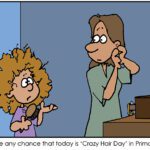Harry Potter and the Uses of Enchantment
by Marilyn Green Faulkner
Editors’ Note: The Harry Potter books have been a publishing sensation. Non-readers have suddenly become converts to the written page, eager to hear about the next adventures of Harry at Hogwarts’ School. Parents sneak a few extra pages when they read with their children at night. Yet, some Christian groups have claimed that the sorcery and wizardry of the dark side described in the book is bad for children. Here’s the perspective of one very literate Latter-day Saint mother on the issue.
Two years ago I noticed a small review in the back of Time Magazine for a book about a boy named Harry Potter. I was intrigued, both by the subject and the author’s rags-to-riches story, and I picked up the book to read aloud to our youngest child, then an avid reader of seven. Well, by the time we finished the first chapter Blake and I were hooked. Our standard twenty minutes per night of reading aloud were forgotten, and instead each night we read until my voice gave out. As the book grew more frightening we had to give up reading at night or Blake couldn’t sleep, so we read early in the morning until the pressures of the impending day bore down upon us and we were forced to quit. I freely admit that while other good Mormon families were studying their scriptures, Blake and I were happily wandering the halls of Hogwarts’ school for wizards. We told everyone about Harry, (and so did many others, for soon we saw him appear in the newspaper, on television, and finally on the cover of Time). As its popularity grew I began to hear comments from some of my friends who were concerned about the role of the occult in the book, as well as its dark undertones. The villain of the series, Lord Voldemort, is a Satanic figure who murders Harry’s parents and seeks the enslavement of the world. Perhaps even more disturbing are the good characters, which include witches, goblins, trolls and a whole bestiary of strange creatures. The presence of these elements in the Harry Potter books has fundamentalist Christians questioning their value. As the popularity of the series grows we should ask ourselves, are these appropriate books for young children, and particularly for young Latter-day Saint children? Is Harry Potter just good fun, or should we be wary of its method and message?
The Harry Potter series, as everyone knows by now, is a publishing phenomenon. The fourth volume, titled Harry Potter and the Goblet of Fire, was the largest single print edition in history, and sold out within minutes after midnight on July 8th, 2000. Parties and celebrations were held in bookstores on both continents, and children and their parents stood in line for hours to get a copy of the 734-page volume. Since when did kids stand in line for a book? Video games or Cabbage Patch dolls we can understand, but what makes them line up in this media-saturated age for a big, thick, rather difficult book? There are some good reasons why Harry Potter has bewitched the under-twelve set. First and foremost is the writing, for J.K. Rowling has a wonderful talent for telling a tale. She is funny without being silly and never maudlin. Her characters, from the disgusting Dursleys to the loveable giant Hagrid to the sage Dumbledore, come to life as distinct individuals. Rowling has the Dickensian knack of marking characters with identifying patterns of speech and mannerisms that keep them separate and memorable, even with a long wait between volumes. Harry Potter himself is as endearing a character as I have ever encountered in literature, and he has the complexity of personality to carry the series without exhausting our interest. Like David Copperfield or Huck Finn, we want to spend time with Harry, to watch him grow and learn, even to watch him make mistakes. A creation like that is rare in literature, and always an event to be celebrated.
But beyond good writing, Rowling has tapped into a powerful medium in Harry Potter, one that was also understood by George Lucas when he created the Star Wars series: the mythical, magical element in the stories has a magnetic effect on children. The first chapter of the first volume is titled, “The Boy Who Lived.” That remarkable title alone illustrates the subtle genius at work in these books. Without reading a word of the chapter we know we will meet a boy of destiny, someone whose life has been threatened and who, for some special reason, has survived. This story of a chosen, orphaned child raised in the home of his comically stupid and stubborn relatives combines the elements of humor and pathos in a way that completely engages the emotions of both parents and children right from the start. Then, when Harry goes to Hogwarts’ school for wizards, the intellect and the imagination become involved as well, for the place is full of mysteries and riddles, literary allusions and magical illusions. It is no wonder that millions are entranced by Harry’s world. It is so much more interesting than our own!
But it is, after all, a world of witchcraft. As Latter-day Saints we are wary of the occult and recognize it as one of Satan’s tools to lead people astray. Spells and potions are sensational substitutes for the real powers of the Priesthood. Should we be reading to our children about werewolves and wizards? Will Harry Potter corrupt them in some way? Some thoughts about the function of fairy tales and fantastic fables may be helpful as we decide how much of Harry’s world to invite into our homes. The title of this article comes from a book I read many years ago as I was beginning to raise our five children. Like many parents I was concerned about which types of books and programs to share with small children. Convinced that peace in the world must begin in the home, I vowed that there would be no toy guns in the house and no violent programs on our television. (This was, of course, before I learned that children can make weapons out of anything from paper clips to celery sticks.) As I began to read stories to my children I was alarmed by the violent content of nearly every traditional fairy tale and legend. Should I be reading them stories of wicked witches and villainous step-parents? Then one day I stumbled upon a volume titled The Uses of Enchantment: The Meaning and Importance of Fairy Tales, a landmark study by the child psychologist, Bruno Bettelheim. He asserts that violent, frightening tales that include magic and mystery are not harmful to children, but instead allow them to experience, in a manageable form, the terrors and confusion of real life, while enjoying a triumphant resolution to conflict through the actions of the hero of the tale. Even critics of Rowling’s series would admit that her books fit his description of the ideal children’s story:
“For a story truly to hold the child’s attention, it must entertain him
and arouse his curiosity. But to enrich his life, it must stimulate his imagination;
help him to develop his intellect and to clarify his emotions; be attuned to his
anxieties and aspirations; give full recognition to his difficulties, while at the
same time relate to all aspects of his personality – and this without ever belittling
but, on the contrary, giving full credence to the seriousness of the child’s
predicaments, while simultaneously promoting confidence in himself and
in his future.” (The Uses of Enchantment, p. 5)
Harry Potter, weak, orphaned, and rather nerdy, is a hero to whom every child can relate. By placing Harry in a parallel universe with different rules, Rowling is free to explore the challenge of behaving morally in a foreign environment. This is, of course, the challenge of every child, since the adult world is a foreign place where the child must learn to survive and hopefully to thrive. Like Travers’ Mary Poppins and Dahl’s Willy Wonka, the saintly wizard Dumbledore teaches children to behave better than the adults around them through a magical perspective on life. Without the element of magic the fairy tale becomes just another story. It is the magical element that brings the tale into a deeper realm of the imagination. In a magical world there may be evil, but there is also power available to overcome that evil. Perhaps this is why little children like Blake beg to hear these stories. Even though they are frightening, they are also empowering.
C.S. Lewis understood this principle and used it to create his wonderful series, The Chronicles of Narnia. Lewis was writing a Christian allegory for children, and for this reason it would seem that everyone would approve of the Chronicles, but this is not the case. Because the books are full of witches and magical creatures, those who fear any mention of such matters reject them, along with The Wizard of Oz, T.H. White’s The Once and Future King (on which Disney’s movie The Sword in the Stone is based), and all of Tolkein’s Hobbit series. Even a cursory perusal of children’s classics shows that magic is an important element in children’s literature. If we reject literature because it is magical, we may reject that very element within it that engages the whole child. I suspect that the interest all children have in the magical is connected to their spiritual development. Rather than fear and avoid the magical, we might use it to help the child develop a believing heart. Certainly in the minds of young children there is little difference between God, Santa Claus and Merlin the Magician. We can use the mythical to move toward the truly spiritual, helping our children understand the qualities in mythical figures that point us toward the source of all good, our Heavenly Father.
The most important use of magical stories, in my opinion, is the empowerment of the child. Fables are evil when they are used to discredit faith and destroy hope in the future. Tolkien wrote that four elements were necessary in any good tale: fantasy, recovery, escape, and consolation. Without a detailed explanation of these elements it is enough to say that the great tales of fantasy include magical elements, terrifying losses and obstacles, recovery and escapes, and a satisfying resolution through moral action. All of the great books I have listed include these elements, including Harry Potter. Crucial to such tales is the happy ending, what Tolkien called, the “sudden, joyous turn,” which leaves the reader hopeful about the world and his or her place in it. In each volume, Harry and his friends face seemingly insurmountable obstacles and emerge victorious. Though Voldemort may rise again, Harry and his friends will be ready for him, and so will we. It is this resolution which, in my opinion, justifies the presence of evil elements in the tale.
Given the overwhelming popularity of this series, there may be something more than magic to concern us in the Harry Potter books. Though I am sure she is a fine person, J.K. Rowling certainly does not share our values and ideals on every level. Through her books she wields tremendous power with literally millions of children. Rowling has mentioned that the books will tend to grow darker as the series progresses, and just the It is to be hoped that her moral vision, which has been admirable so far, will continue to shine forth in a hopeful way through the volumes, but of this we cannot be sure. I would suggest that these books should be read aloud, or at least that parents read each book at the same time as the child, so that the values implicit in the narrative can be discussed in detail. There are so many good messages in these books that those few that are negative can be dealt with through discussion. Blake and I love to talk about each chapter as we go: Why does Harry need to act in certain ways? What allegiance, if any, does he owe his relatives? Which of the characters we encounter will turn out to be the “bad guy,” and what qualities contribute to his or her downfall? As long as we are talking as we go, imparting our world view and our religious perspective, a trip to Hogwarts can be a wonderful experience to share with a child.
One of the many insights to be gained from these books is the deceptive nature of evil, and how each of us may, unwittingly, advance the plan of the adversary through our pride or our ignorance. Blake and I were intrigued in the second volume when the innocent little sister of Harry’s best friend was drawn into Voldemort’s evil plan. Ginny Weasley finds a fascinating diary that writes back to her when she writes in it. The diary serves as a conduit for the evil Lord Voldemort to emerge anew, and Ginny is horrified to learn at last that she has been his agent. As the story reaches its dramatic climax Rowling softens the lesson with her characteristic humor. Ginny confesses that she has been writing in a diary that writes back to her and is reprimanded by her father: “Ginny!” said Mr. Weasley, flabbergasted. “Haven’t I taught you anything? What have I always told you? Never trust anything that can think for itself if you can’t see where it keeps its brain?” (Chamber of Secrets, p. 329) The Weasley family is a fine example of a large, happy family with strong moral values, and Rowling’s message is clear here: good parents will guide us the right way. Cloaking it in such humorous magical garb makes the message easier to swallow. Certain characters emerge as villains through their pride, vanity or a lust for power. Others emerge as heroes through humility, curiosity, courage and integrity. Rowling’s vision is of a world where goodness will triumph and evil will be overcome, often by the weak and simple. This is a vision that corresponds to ours.
The Harry Potter books are scary, and they are going to get scarier. The same may be said of the world around us. Every parent wishes to shield the child from the terrifying and horrible realities of life, yet children are aware of these realities from an early age. Many things frighten them and nearly everything is confusing. What they need is confidence that their fears can be overcome and adults will help them find the right way. In Bettelheim’s words: “fairy tales are loved by the child because – despite all the angry anxious thoughts in his mind to which the fairy tale gives body and specific content – these stories always result in a happy outcome, which the child cannot imagine on his own.” (Enchantment, p. 123) J.K. Rowling has given us, through the Harry Potter series, another vehicle to help children come to grips with a frightening world and to visualize their ability to overcome the evil and embrace the good. For this reason, as well as for many delightful hours shared with my son, I am an enthusiastic, though watchful, fan. And, all you Muggles, don’t bother to call after July 8th; we’re taking the phone off the hook and heading back to Hogwarts!
2001 Meridian Magazine. All Rights Reserved.

















